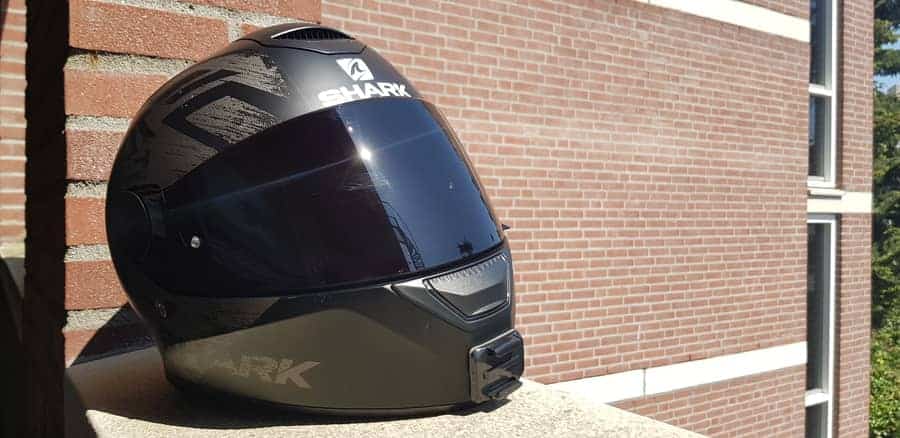Disclaimer: I am a motorcycle gear enthusiast. I’ve put a lot of effort into making this article. Laws change over time and despite my effort, some information could be outdated. Always check the laws at the responsible authorities. Found any inaccurate information in this article? Please leave a comment below and I’ll change it straight away.
In this article, I’ll tell you if tinted motorcycle visors are legal in your country or state, and my personal opinion on tinted visors in general.
Are tinted visors legal on a motorcycle helmet?
Tinted visors on motorcycle helmets are legal in some countries, whiles they are illegal in other countries. This list will tell you if they are legal in your country.
| Country | Is it legal? |
| Australia | Criteria: The visor should comply with the AS1609 standard |
| Canada | Yes |
| New Zealand | Yes |
| United Kingdom | Criteria: During the daytime. The visor may not block more than 50% of the light. |
| United States | Yes |
Disclaimer: Do your own research! The content of this article is provided for information purposes only. No rights can be derived from the information provided.

Smoked vs. dark tint vs. mirrored visors
There are three main types of tinted visors that will protect your eyes from the sun. It’s the smoked visor, a dark tinted visor, and a mirrored visor.
This article mainly reflects on the dark tinted visor as seen on the pictures of my helmet. But I would like to tell you a little bit more about the different types of tinted visors.
Smoked visor
A smoked visor can be described as a clear visor with a little bit of smoke in/over it. It’s not very dark, but it takes the sharp edges of the sun away and stops some of the eye fatigue.
A smoked visor is, hower, a broad term. They come in different percentages of brightness. The percentage tells you how much light is blocked (or able to get through). A visor with a 50% brightness allows 50% of the light to go through and blocks the other 50% of the light. That’s actually the limit for tined visors in the UK, but you can read more about that below.
Dark tinted visor (black)
A dark tinted visor is basically the same as a smoked visor. The main difference is the level of darkness. A dark tinted visor blocks most of the light out, making it appear black.
The pictures of my helmet in this article show you a dark tinted visor.
Mirrored visor
A mirrored visor is a visor that reflects the light like a mirror. They do not show any light from inside the helmet, making it impossible to see the eyes of the rider wearing the helmet.
Mirrored visors come in all sorts of colors. They are great for bright summer days but illegal in most countries since they block most of the light out.
Are tinted visors any good?
I can be short about this. Tinted visors are a blast for your eyes on those hot summer days! They stop most of the eye fatigue and they also keep the heat out of your helmet quite a bit.
On top of that, they just look very nice. I would lie if I would say that that wasn’t one of the reasons to buy a visor like this.
The only problem is nighttime. The dark visors just don’t work when the sun is going down! I mean, it doesn’t matter if it’s legal or not. You’re just simply unable to see the road and other traffic properly.
I usually only ride during the day, but I’ve been caught off guard last easter. I was eating out with the family and we were having a great time. Before I knew, it was 8.30PM and I still had to drive home for 40 minutes.
I left when it was still sunny, but it got dark real soon. I ended up driving very slowly with my visor up because I couldn’t see anything at all.
It’s seriously a thing to keep in mind. It’s no problem if you have panniers, just take the original clear visor with you. But it’s hard when you have a naked bike like me. Look into these glasses (link to Amazon) if you don’t want to take a clear visor with you all the time. It doesn’t hurt your wallet and it fits right in your pocket. Better safe than sorry!

Is a dark tinted visor legal in your country? The details I’ve found.
Australia
It is illegal to ride with a tinted visor at night. The visor should comply with the AS 1609 standard. You can check this by looking for the standards mark on any visor. They should be applied to the visor itself. Just make sure to never remove it, since this makes it impossible to check if the visor meets the requirements.
Some searches on the internet reveal that Australian police officers rarely issue tickets for tinted visors.
Source:
Vicroads Australia: https://www.vicroads.vic.gov.au/-/media/files/formsandpublications/safety-and-road-rules/motorcyclestherightstuffguidetoprotectivegear.ashx?la=en&hash=866CDEF7E9F2B409C0D2A72A881957FE
Canada
It was super hard to find any information about tinted visors in Canada. I couldn’t find any legal or government site that wrote about it.
This makes me believe that it’s allowed to use tinted visors in Canada. Do you have more information about this? Please leave a comment and provide a link with additional information, so that we can add it to this list.
I’ve checked the Québec government website and it only said that a visor or safety goggles are mandatory. It didn’t say anything about tinted visors, so I think you’ll be fine.
Source:
SAAQ website: https://saaq.gouv.qc.ca/en/road-safety/modes-transportation/motorcycle/helmets-and-protective-gear/
New Zealand
New Zealand doesn’t have any laws regarding tinted visors at all. However, the government advises you to not wear tinted visors when the sun goes down. Even in the twilight, dark visors might limit your visibility.
The tinted visors fade when the sun goes down, so be sure to have a clear visor available when you are going back home in the evening.
Sources:
NZ Transport Agency: https://www.nzta.govt.nz/resources/roadcode/motorcycle-road-code/you-and-your-motorcycle/wearing-the-right-gear/
RideForever: https://www.rideforever.co.nz/news-and-reviews/the-dark-side-of-tinted-visors/
United Kingdom
Tinted visors in the UK is a bit of a grey area. The laws have been changed a few times and loads of riders wear tinted visors whiles they are not allowed to.
The legal rule for how tinted a visor can be in the UK is pretty simple. The law says that your visor must allow light transmission of at least 50%. This means that less than 50% of the light can be blocked by the visor.
In general, tinted visors are ok during the day. However, they are not allowed during the night or poor visibility circumstances. This is where the grey area comes in, since ‘poor visibility’ is not a black or white situation.
It comes to the interpretation of the police officer at that moment. So my advice would be to only use tinted visors when it’s super sunny and there is no way somebody could call the circumstances ‘poor visibility’.
Keep in mind that we are talking about tinted visors and not about mirrored visors. Mirrored visors are illegal since they reflect the light and don’t allow any light to go through the visor.
Source: The Bike Insurer: https://www.thebikeinsurer.co.uk/riding-advice-and-guides/tinted-visors-on-your-motorcycle-helmet/
United States
As far as I could find out, it is legal to use tinted visors in the US.
However, some states have a law that makes it mandatory to keep your visor down. You are not allowed to ride with the visor opened, except when you have a big windscreen protecting your face from hazards. This is something to keep in mind because the tickets are 175 dollars!
That’s why I would suggest you take a clear visor with you when you go and ride after sunset. A tinted visor will be too dark to ride at night. You’ll have to eighter open up the visor or change the visor.
Opening up the visor can end you up with a huge fine. That’s why it would be best to take a clear visor with you in your panniers, buddy seat or backpack.
Final thoughts
Tinted motorcycle visors can be great. Make sure you buy a visor that is legal in your country to avoid any expensive tickets. Also, make sure you bring backup in the form of goggles or a clear visor.
I bought my visor second-hand, which is fine in my case. Just remember that you shouldn’t buy a second-hand helmet. This brings the risk of wearing a less-protective helmet.

